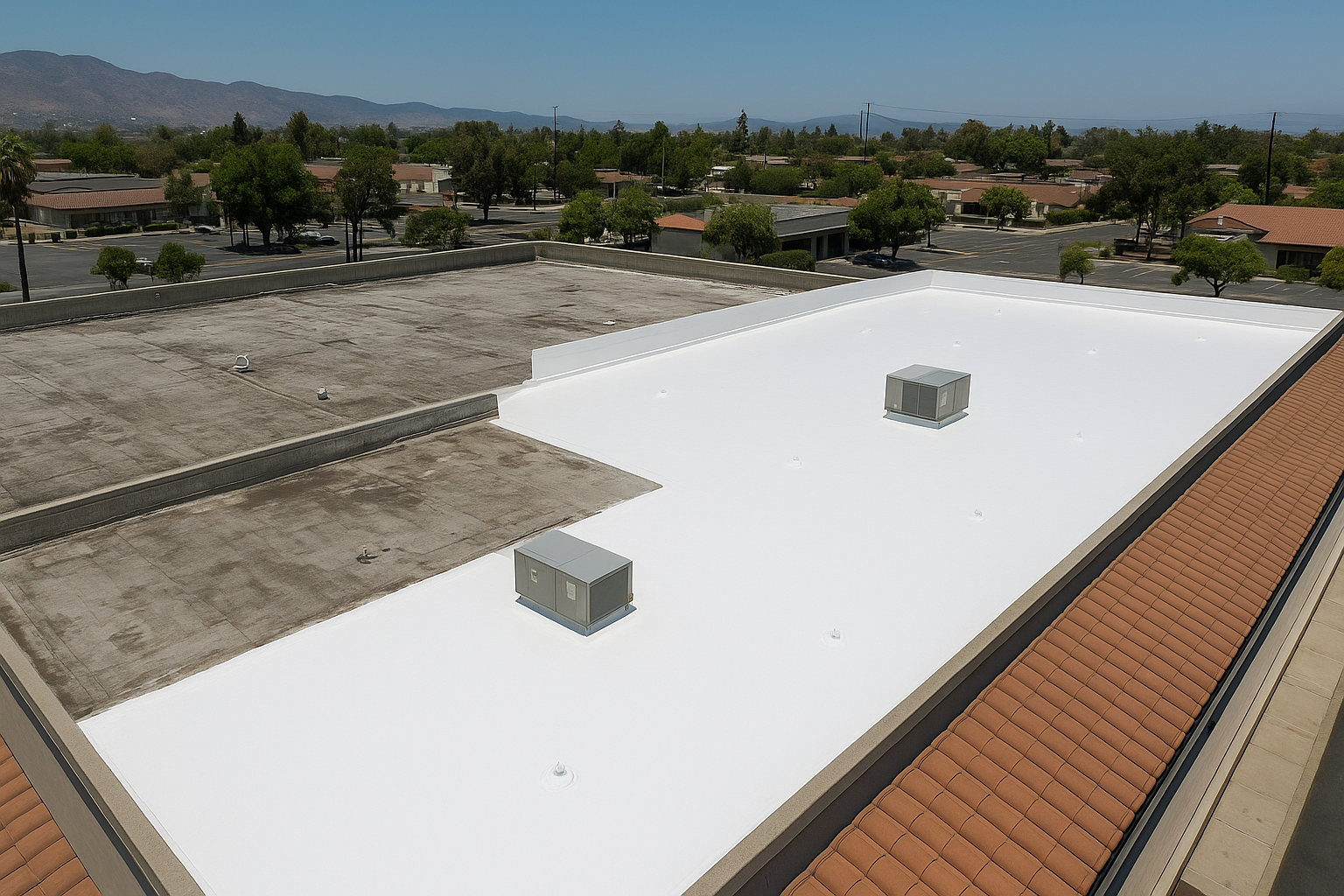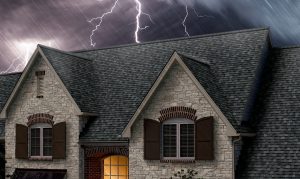If you manage or own a commercial building in Hemet or nearby in the Riverside / San Jacinto area, one question I hear a lot is:
Should You Repair or Replace Your Commercial Roof—And When?
It’s a smart question. The right answer can save you tens of thousands of dollars in unnecessary work, prevent downtime, and give your building long-term protection. Let’s walk through how to decide what’s best for your building, especially here in our climate.
Why This Decision Matters More Now Than Ever
As of 2025, roofing material costs, labor, and supply chain delays are still elevated across the U.S. Many building owners are facing older roof systems that are past their design life. Making the wrong call—repairing too late or replacing too early—both carry risks:
-
Delaying replacement can lead to cascading damage (rot, mold, insulation failure under the membrane).
-
Replacing prematurely means you’re losing the remaining useful life of what remains.
In Hemet, the combination of hot sun, occasional storms, thermal shifts, and seasonal rain storms means your commercial roof takes a beating. It’s important to evaluate carefully now so you don’t get surprised later.
Signs You Should Seriously Consider a Full Replacement
Here are some red flags that usually tip the balance toward replacement rather than patching over repairs:
-
Widespread leaks or multiple problematic zones
If leaks are happening in multiple, disconnected places, structural issues may be more pervasive than localized repair can solve. -
Membrane is beyond its service life
Many commercial roofing membranes (TPO, EPDM, PVC, built-up systems, etc.) have a useful life of 20–25 years. If yours is past that range and already showing age cracks, blistering, or seam failures, repairs may be band-aids. -
Evidence of substrate or deck deterioration
When the insulation panels, roof deck or structural sheathing underneath show rot, delamination, or water saturation, you’re often better off rebuilding rather than trying spot fixes. -
Frequent recurring repairs
If you find yourself calling a roofer every year—or multiple times in a season—to patch leaks, the cumulative repair cost can approach or exceed a replacement cost. -
Poor thermal performance or energy loss
An aging roof may no longer insulate well or reflect heat. A new roof system can improve energy efficiency and reduce HVAC load. -
Code changes or building upgrades
If local building codes or zoning require upgrades (e.g. new drainage, wind uplift ratings) or you plan to renovate or expand, a full replacement ensures you do it all at once rather than in disruptive phases.
When Repairs Still Make Sense (and How to Do Them Right)
Repairs remain a practical, cost-effective solution when:
-
The damage is isolated (a small pond, flashing failure, seam issues)
-
The roof is relatively young (mid-life)
-
The underlying deck and insulation are in solid condition
-
You pair repair with a proactive maintenance plan
If you go the repair route, do it smartly:
-
Use the same or compatible membrane type for patches to avoid incompatibility or bonding issues
-
Reinforce flashing and transitions (these are frequent weak spots)
-
Ensure a qualified roofing crew inspects adjacent areas to catch creeping damage
-
Keep meticulous documentation and photographs of the work
Repairing buys you time—but only if you don’t delay evaluation. A half-year delay on a leak today can turn into a full-blown re-roof next year if water intrusion accelerates damage.
The Cost Consideration: What to Budget
One of the most common questions is “How much will it cost?” The truth is: there’s no one-size-fits-all answer. It depends heavily on:
-
Roof size (square footage)
-
Roof complexity (penetrations, curbs, vents, HVAC equipment)
-
Membrane type and thickness
-
Substrate condition (how much deck/insulation replacement is needed)
-
Local labor rates, clearance, access, and disposal logistics
Broadly, repair projects may run from a few dollars per square foot to mid-double digits, while full replacements often land in the $10–$25+ / ft² range (or more, depending on all the variables). (Note: these are ballpark figures and can vary drastically by region and specifics.)
That’s why a professional commercial roofing inspection is the first step—so you get a custom scope and estimate, not guesswork.
What to Expect During a Roof Replacement in Hemet
If you decide to replace, here’s what typically happens:
-
Roof inspection & evaluation
A certified roofing contractor will survey the system, take core samples, detect moisture, examine deck condition, and review drainage. -
Specification & bid documents
Based on inspection, the contractor prepares detailed plans for the new roof system, profiles, materials, and warranties. -
Permitting & code compliance
Some scope may need local permits, inspections, and adherence to Hemet / Riverside County building codes. -
Removal & substrate prep
The old roof is stripped, substrate cleaned, any damaged deck or insulation is replaced or reinforced. -
New roof installation
The new membrane (TPO, PVC, EPDM, etc.), flashings, edge metal, interface details are installed meticulously. -
Quality assurance & testing
Walk the roof, inspect seams, perform adhesion or pull tests (if applicable), ensure drainage, and address punch-list items. -
Final cleanup & documentation
Disposal, job-site cleanup, and providing you as owner with as-built documents, warranties, and maintenance guidance.
Questions to Ask Before You Commit (so You Don’t Get Burned)
Before signing on any job, make sure your contractor can answer these clearly:
-
Are you licensed, insured, and bonded for commercial roofing in Riverside County?
-
Can you show me past projects similar to mine—especially local ones?
-
What manufacturer certifications do your crews hold?
-
Who will supervise the project onsite?
-
What type of warranty do you offer on workmanship and materials?
-
How will you minimize disruption to our business during installation?
-
What safety measures will you follow?
-
How will drainage, thermal expansion, wind uplift, and flashings be handled?
-
What happens if you uncover hidden damage or structural issues mid-project?
-
What is projected timeline, and how will delays (weather or permit) be handled?
Asking pointed questions is critical. Reputable contractors expect and welcome them.
Why Local Expertise in Hemet Makes a Big Difference
The Hemet area has unique challenges:
-
High UV and heat exposure — your roof sees intense sun for much of the year, so membrane durability and reflectivity matter.
-
Occasional heavy summer storms— flash floods, wind, ponding water issues.
-
Thermal cycling— big day/night temperature swings can stress seams and membranes.
-
Dust, wind, and debris— mountain winds may bring grit that accelerates wear.
A roofing company that knows these local conditions—and understands Riverside County building codes—will design and install a system that lasts. That’s one reason local firms often outperform out-of-town bidders.
Long-Term Strategy: Maintenance, Inspections & Lifespan
No matter whether you repair or replace, maintaining your roof pays off. A solid maintenance plan includes:
-
Semi-annual inspections (after winter rains, before summer heat)
-
Debris removal, drain clearing, seam/flashing checkups
-
Spot repairs on small issues before they escalate
-
Periodic roof coating or surface rejuvenation if compatible
With care, many commercial roofs last well beyond their warranty period. But neglect accelerates wear, reduces lifespan, and often forces premature replacement.
Bottom Line For Hemet Property Owners
If your commercial roof is showing age, leaks, or structural distress, don’t gamble on quick patches. Evaluate whether a full replacement gives you better long-term value and peace of mind. On the other hand, if damage is localized and your roof still has many good years left, a well-executed repair plus a proactive maintenance strategy can make sense.
Either way, start with a thorough inspection from a certified roofing contractor who knows Hemet and the Inland Empire climate. Once you have that scoped plan and estimate in hand, you’ll be able to decide with confidence.
If you ever want help understanding proposals or comparing options, I’d be happy to walk you through them—or help you refine the questions to put to your contractors.







